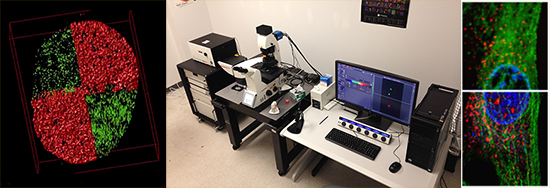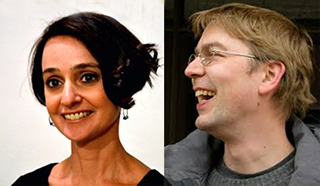Shedding Greater Light
 |
|
At left, a surface-rendered 3D reconstruction of a cell through use of a STimulated Emission Depletion (STED) system; center, a microscope workstation similar to one now available to area scientists; right, differing resolutions of a cell from a conventional confocal microscope (at top) and with STED (bottom).
|
ALBANY, N.Y. (September 26, 2018) — Biophysicist Annalisa Scimemi, an expert in two-photon microscopy, has something in common with the 2014 Nobel Prize winner in chemistry, Stefan Hell — a desire to clearly view the extreme nanodimensions of small molecules that inhabit living cells.
Hell, along with Eric Betzig and William Moerner, earned the Nobel for the development of a super-resolution microscopy technique called STED (Stimulated Emission Depletion). The discovery essentially opened up new fields for scientists to witness such phenomena as the distribution of chromosomes, the way in which nerve cells are constructed, and if and how they change shape when organisms learn something new.
 |
|
UAlbany biophysicist Annalisa Scimemi and Yale cell biologist Joerg Bewersdorf. Bewersdorf will speak on the revolution in microscopy next Wednesday in the LSRB. |
Microscopy will be celebrated and reflected upon when Yale University’s Joerg Bewersdorf, who trained with Hell and is a long-time contributor to the field of super-resolution microscopy, delivers the lecture “Seeing the Unseen: A Revolution in Microscopy” next Wednesday, Oct. 3, at 7 p.m. in the D’Ambra Auditorium of the Life Sciences Research Building. Bewersdorf’s talk will be geared toward the general public.
Celebrated as well will be the fact that scientists in the Capital Region, including those at UAlbany, have a STED microscope ready to use. Housed at RPI, the instrument was purchased through an award from the National Science Foundation, via the collaborative efforts of UAlbany, RPI, Albany Medical Center and Wadsworth Center.
“From now on, in Albany, blurred pictures of living cells are a thing of the past,” said Scimemi, an assistant professor of Biological Sciences and an adjunct in Physics. She described how, before STED, conventional microscopes allowed us to see things that were 5,000 times smaller than the tip of a pencil. “But anything smaller than that only looked like blurred light. Just imagine how you would see the world if you had no chance of wearing a pair of glasses to correct your vision?
“The dogma at the time was that this problem could not be resolved: The physical properties of light would just not allow seeing things that were too small. Stefan proved this to be wrong. By using STED, he and his team managed to see objects that were 10 times smaller than anything that had been seen before.”
Through her own use of two-photon microscopy, Scimemi has come to understand new features about the structural organization of pre-synaptic terminals in the hippocampus. She said she looks forward to what Bewersdorf will tell us about STED, its workings and newest applications, and how she and other scientists can use it to advance the study of molecular behavior within cells.
Registration through eventbrite is requested.
![]() For more news, subscribe to UAlbany's RSS headline feeds
For more news, subscribe to UAlbany's RSS headline feeds
A comprehensive public research university, the University at Albany-SUNY offers more than 120 undergraduate majors and minors and 125 master's, doctoral and graduate certificate programs. UAlbany is a leader among all New York State colleges and universities in such diverse fields as atmospheric and environmental sciences, business, education, public health,health sciences, criminal justice, emergency preparedness, engineering and applied sciences, informatics, public administration, social welfare and sociology, taught by an extensive roster of faculty experts. It also offers expanded academic and research opportunities for students through an affiliation with Albany Law School. With a curriculum enhanced by 600 study-abroad opportunities, UAlbany launches great careers.


